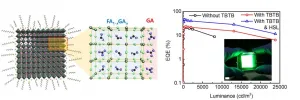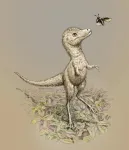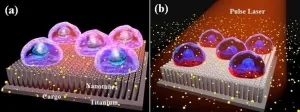(Press-News.org) Public health researchers, led by UNSW Sydney, have estimated the number of cancer cases requiring surgery globally each year, predicting the number will rise from 9.1 million to 13.8 million from 2018 to 2040 - an increase of 52 per cent or 4.7 million cases.
Their research shows the greatest relative increase will occur in 34 low-income countries, where the number of cases requiring surgery is expected to more than double by 2040 (314,355 cases to 650,164, or 107 per cent).
The modelling study, published in The Lancet Oncology on Friday, analysed global demand for cancer surgery and estimated surgical and anaesthesia workforce requirements between 2018 and 2040.
Lead author Dr Sathira Perera, a UNSW Scientia PhD scholar, said an absence of evidence-based estimates of future demand had restricted efforts to improve cancer care around the world.
Cancer is a leading cause of death and disability globally, and has substantial economic impacts, with recent evidence suggesting a disproportionate burden of disease in low- and middle-income countries.
"Our analysis has revealed that, in relative terms, low-income countries will bear the brunt of increased future demand for cancer surgery, bringing with it a need to substantially increase numbers of surgeons and anaesthetists," Dr Perera said.
"These findings highlight a need to act quickly to ensure that increasing workforce requirements in low-income countries are adequately planned for. There needs to be an increased focus on the application of cost-effective models of care, along with government endorsement of scientific evidence to mobilise resources for expanding services.
"In addition, access to post-operative care is strongly linked to lower mortality - so, improving care systems globally must be a priority in order to reduce the disproportionate number of deaths following complications."
The modelling study was an international collaboration between researchers from UNSW Sydney, University of Toronto, Kings College London, and the World Health Organization.
The researchers used best-practice guidelines, patient characteristics and cancer stage data to calculate the proportion of newly diagnosed cancer cases requiring surgery in 183 countries.
To predict future surgery demand, they applied these rates to GLOBACAN cancer incidence predictions from 2018 to 2040.
The study did not assess the impact of COVID-19, but the researchers acknowledge the delivery of high-quality post-operative care is more challenging during a pandemic.
Global shortage of surgeons, anaesthetists
To deliver cancer surgery services optimally now and in future, the researchers also predicted requirements for surgical and anaesthesia workforces.
To evaluate current staffing gaps, they compared the optimal estimated workforce (the median workforce of 44 high-income countries) with the number of surgeons and anaesthetists in each country.
Dr Perera said there was a current global shortage of 199,000 surgeons and 87,000 anaesthetists.
"This is based on the current workforce of 766,000 surgeons and 372,000 anaesthetists, compared with 965,000 and 459,000 needed for an optimal workforce, respectively, in our modelling study," he said.
"The gap is estimated to be greatest in low-income countries, where the current surgeon availability is 22,000 fewer than the model estimated optimal number of 28,000 surgeons.
"The current number of anaesthetists in low-income countries falls 11,000 below the model estimated demand of 13,000 anaesthetists."
Optimal workforce estimates for 2040
In recognition of the rising global demand for cancer surgery, the researchers also calculated estimates for the optimal surgical and anaesthesia workforces needed in 2040.
Extrapolating 2018 data, taking account of the predicted future cancer incidence burden in each country, their findings revealed the surgical workforce will need to increase from 965,000 in 2018 to 1.416 million in 2040 (a 47 per cent increase).
The anaesthetist workforce would need to rise from 459,000 in 2018 to 674,000 in 2040 (a 47 per cent increase).
The researchers found the greatest relative increase in optimal workforce requirements from 2018 to 2040 would occur in low-income countries, where surgeon numbers are required to rise from 28,210 to 58,219 by 2040 (106 per cent).
Anaesthetist numbers would also need to increase from 13,000 to 28,000 by 2040 (115 per cent).
Dr Perera said: "But to match the current benchmark of high-income countries, the actual number of surgeons in low-income countries would need to increase almost 400 per cent (from 6,000 to 28,000), and anaesthetists by almost 550 per cent (from 2000 to 13,000), of their baseline values.
"This is because the current workforce in low-income countries is already substantially smaller than in high-income countries."
Potential limitations
The researchers acknowledged that estimates in their study relied on several assumptions.
Dr Perera said: "We based predictions of future cancer rates on 2018 estimates, but country-level changes - such as economic developments or altered capacity to screen for early diagnosis - could impact cancer incidence and therefore surgical demand and workforce requirements.
"Furthermore, observed gaps in the workforce could also be narrower than the actual gaps in practice - our predictions were conservative because we only considered initial surgical encounters without accounting for follow-up interactions."
INFORMATION:
Find the study in The Lancet Oncology: https://doi.org/10.1016/S1470-2045(20)30589-1 END
Research team at Seoul National University (Prof. Tae-Woo Lee) and University of Pennsylvania (Prof. Andrew M. Rappe) developed perovskite light-emitting diodes (PeLEDs) with an external quantum efficiency (EQE) of 23.4%. The research results were published in Nature Photonics, which is the world-renowned international academic journal, on January 4th (Title: Comprehensive defect suppression in perovskite nanocrystals for high-efficiency light-emitting diodes).
Metal halide perovskites have very narrow spectral emission, excellent color purity, low material cost, and wide and easy color-tunability. ...
The Nagoya University Institute of Transformative Bio-Molecules (WPI-ITbM) research team of Designated Associate Professor Tsuyoshi Hirota, Postdoctoral Fellow Simon Miller, Professor Kenichiro Itami and graduate student Tsuyoshi Oshima (Research Fellowship for Young Scientists, JSPS), in collaboration with the group of Professor Ben Feringa and Postdoctoral Fellow Dušan Kolarski of Groningen University in the Netherlands, have achieved a world first: fully reversible manipulation of the period of the circadian clock using light, by exchanging part of a compound with a light-activated switch.
Waking in the ...
Greater sports participation among Aboriginal and Torres Strait Islander children is linked with better academic performance, according to new research from the University of South Australia.
Conducted in partnership with the University of Sydney and the University of Technology Sydney, the world-first study found that Aboriginal and Torres Strait Islander children who played organised sports every year over four years, had numeracy skills which were advanced by seven months, compared to children who did less sport.
The study used data from four successive waves of Australia's Longitudinal Study of Indigenous Children, following 303 students (with a baseline age of five to six years old) to assess cumulative sports participation against ...
A world-first discovery by researchers at Monash University and The University of Queensland could lead to faster and more effective treatments for chronic health complications, such as cardiovascular disease and cancer, with 'fluorescent' in vivo biosensors.
The research team, led by Dr Simon Corrie from Monash University's Department of Chemical Engineering and the ARC Centre of Excellence in Convergent Bio-Nano Science and Technology, took an antibody that binds EGFR (epidermal growth factor receptor) proteins and engineered it to monitor the concentration of EGFR proteins in serum solutions over time.
Co-authors of the paper, published in ACS Sensors, are Dr Christian Fercher, Dr Martina ...
They are among the largest predators ever to walk the Earth, but experts have discovered that some baby tyrannosaurs were only the size of a Border Collie dog when they took their first steps.
The first-known fossils of tyrannosaur embryos have shed light on the early development of the colossal animals, which could grow to 40 feet in length and weigh eight tonnes.
A team of palaeontologists, led by a University of Edinburgh researcher, made the discovery by examining the fossilised remains of a tiny jaw bone and claw unearthed in Canada and the US.
Producing 3D scans of the delicate fragments revealed that they belonged to baby tyrannosaurs ...
Scientists from UNSW Sydney have developed a ceramic-based ink that may allow surgeons in the future to 3D-print bone parts complete with living cells that could be used to repair damaged bone tissue.
Using a 3D-printer that deploys a special ink made up of calcium phosphate, the scientists developed a new technique, known as ceramic omnidirectional bioprinting in cell-suspensions (COBICS), enabling them to print bone-like structures that harden in a matter of minutes when placed in water.
While the idea of 3D-printing bone-mimicking structures is not new, this is the first time such material can be created at room temperature - complete with living cells ...
The carbon footprint of plastic production for initial use is greater than the global warming impact of the entire process used for medical device reprocessing Use of reprocessed devices is environmentally superior to use of original products in 13 of 16 categories evaluatedReprocessing found to advance "circular economy," a key strategy for reaching the UN Sustainability GoalsLCA offers evidence showing that in order to reduce greenhouse gas emissions and honor the Paris Climate Agreement, EU Member States must opt-in to EU Medical Device Regulation (MDR)'s reprocessing/remanufacturing provisions
[Berlin / Washington, ...
Large-scale production of vegetables and fruit in Spain with intensive plastic consumption in its greenhouse industry is believed to have leaked microplastic contaminants since the 1970s into the surrounding Mediterranean seagrass beds. This is shown in a new study where researchers have succeeded in tracing plastic pollution since the 1930s and 1940s by analyzing seagrass sediments.
About half of Sweden's cucumbers and a fifth of the tomatoes in Sweden are currently imported from Spain according to the Swedish Board of Agriculture. A special area in Spain where large-scale vegetable cultivation ...
Overview:
A research team at the Department of Mechanical Engineering at Toyohashi University of Technology developed a nanosecond pulse laser-assisted photoporation method using titanium-oxide nanotubes (TNTs) for highly efficient and low-cost intracellular delivery. The proof of concept for the possibility of intracellular delivery after irradiation with nanosecond pulse laser on TNTs was validated. TNTs were formed on titanium sheets using the electrochemical anodization technique at different voltages and times. HeLa - human cervical cancer cells were cultured in the nanotubes and submerged in a solution of biomolecules. After cells were exposed to nanosecond pulse laser, we successfully delivered ...
There isn't much in Kamchatka, a remote peninsula in northeastern Russia just across the Bering Sea from Alaska, besides an impressive population of brown bears and the most explosive volcano in the world.
Kamchatka's Shiveluch volcano has had more than 40 violent eruptions over the last 10,000 years. The last gigantic blast occurred in 1964, creating a new crater and covering an area of nearly 100 square kilometers with pyroclastic flows. But Shiveluch is actually currently erupting, as it has been for over 20 years. So why would anyone risk venturing too close?
Researchers from Washington University in St. Louis, including Michael Krawczynski, assistant professor of earth and planetary sciences in Arts & Sciences and graduate student ...






